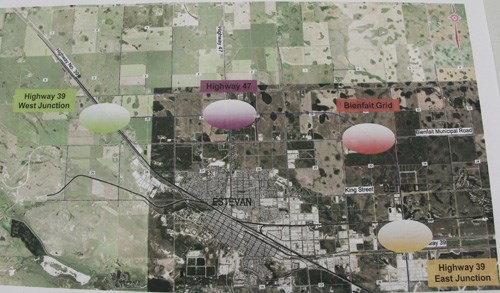When it comes to Saskatchewan roadways, the province is in a state of constant planning.
With construction ongoing this summer on the Estevan heavy-truck bypass, the Ministry of Highways and Infrastructure released numerous proposals for how interchanges may be introduced onto the bypass to improve traffic flow when volumes on the route increase. An open house June 18 welcomed the public to view numerous concepts and leave feedback on what may work best for traffic changing onto the bypass either from Highway 39 west and east of Estevan or from Highway 47.
These interchanges, however, will not be built in concert with the bypass. While the bypass has been long in the works and now has a completion date of fall 2014, the interchanges will come long after, when the Ministry has an opportunity to study traffic along the route and determine the necessity and structure for interchanges on and off the bypass.
Mark Rathwell, senior communications consultant with the Ministry of Highways and Infrastructure, said when it comes to engineering access on and off the truck route, they're in the brainstorming stages.
"There's not a preferred concept at this point. That's what this meeting is about, to gauge people's reaction to the concepts that are out there and take that feedback and put it into the mix of the overall planning process," said Rathwell. "We're at the very early stages of this. This is about gathering information, getting input and adding it to the mix.
There were a number of concepts for the public to review during the open house, and many of those options had stages of development. For one example where the bypass crosses Highway 47, the Ministry presented a roundabout as the first stage. The second stage, if traffic continued to increase to a point where the roundabout was too burdened, would include an overpass whereby the traffic crossing the highway would continue over the intersection. Vehicles transitioning from the bypass to the highway or vice versa would take an exit ramp into the roundabout.
"I think what it is, is it's about looking at what is the best option going forward. If you look at some of the plans, it looks at all the interchanges as one so to speak, but it looks in terms of phasing them in. It's not about creating a standard; it's about creating the best option at each intersection," said Rathwell.
"Really, at this stage, anything is on the table in terms of how we go forward and where we go from here. It's all going to be based on the traffic volumes as they grow. It will be dependent on the traffic volumes, how the community grows, that type of thing,"
The intersections and access points being built during the primary construction of the bypass where it connects with the highways will be at-grade crossings.
"The bypass will be operational before the interchanges are. What is being built now, is what we feel through mock traffic modeling is the best option in terms of dealing with the volume of traffic that exists right now. The interchanges will come along as traffic volume counts increase, as there is more of a demand that's warranted by the traffic volumes," noted Rathwell.
"This is looking into the future. Let's get the bypass up and running and then the interchanges will come as traffic dictates."
The interchange projects on the bypass must also be balanced with other infrastructure priorities the province has to deal with.
Rathwell added that given the amount of planning required for a project like this, nobody should be holding their breath in anticipation just yet.
"If you look at the truck bypass itself, planning began years ago. It began with this type of a process, with an open house," he said. "There isn't a timeline. All things being equal, the truck route as it is (planned) right now, could accommodate increased traffic volumes up to 20 years, but we live in a growing province and we have a growing economy and those timelines can change.
"Paramount in building these is to ensure driver safety and ensuring they are built in a way that accommodates heavy truck traffic."



